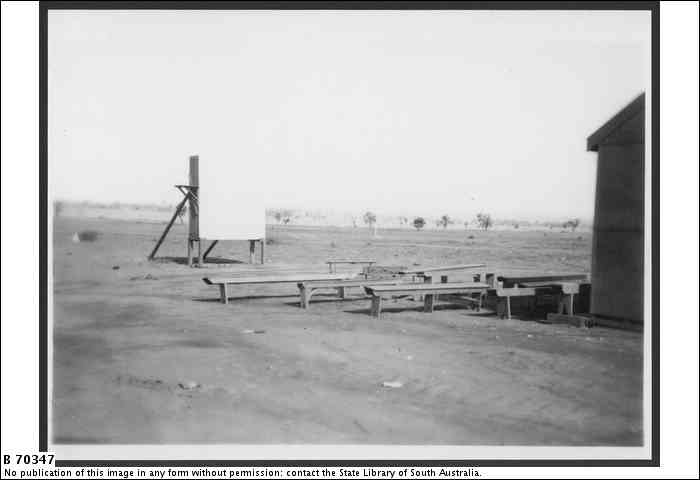Suggest a topic
Suggest a new Did you know? topic

Drive-in theatres
891 ABC Afternoon Delights at the State Library : 22 January 2007
Carole Whitelock talked with Michael Talbot
United States origins
Although they are generally thought of as a 1950's phenomenon, Richard M. Hollingshead Jr obtained a United States patent for a 'new and useful outdoor theater' on 16 May 1933. A 'motion picture show or the like, may be seen and heard from a series of automobiles so arranged in relation to the stage or screen, that the successive cars behind each other will not obstruct the view'.
The world's first Automobile Movie Theatre opened on 6 June 1933. Numbers rose relatively slowly to 95 in January 1942. Development was static during the United States involvement in World War II. Post-war expansion saw 820 in place by 1948. The peak year was 1958 with about 4000, followed by a slow decline.
Australia
The drive-in is a uniquely American institution with Canada and Australia the only other countries adopting them to any great extent.
Australia's first drive-in was the Skyline in the Melbourne suburb of Burwood. An advertisement in the Sun newspaper for 18 February 1954 said 'Opening tonight at 6:30 Australia's first drive-in theater'.
Enthusiast David Kilderry's website - http://www.drive-insdownunder.com.au - lists a total of 308 Australian drive-ins he knows to have existed at one time or another. About twenty are still operating.
Debate in the SA Parliament
During the second half of 1954 the Places of Public Entertainment Act Amendment Bill was debated in the South Australian parliament. With drive-in theatres in the offing the first part of the bill related to them. The Hon. E Anthoney thought they were a good idea in a climate that supported year round outdoor entertainment. The 'family man who, after coming home from work, often does not feel inclined to change ... could put his family in the car and go to the picture show without changing' (SAPD Council, 24 August 1954, p. 442).
A number of speakers were concerned with morality. Mr. Hutchens went into greatest detail: 'No doubt we shall see females attending in green French bathers, with their hair dyed red, and accessories to match. We should take all possible action to preserve the morals of our young people and I am glad we are to have legislation to deal with drive-in theatres' (SAPD Assembly, 5 October 1954, p. 881).
A young Don Dunstan disagreed: 'If people are going to resort to motor cars for the purposes of immorality they are not likely to purchase theatre tickets and drive in beside other vehicles to do what they might otherwise do on some lonely country road. I think drive-in theatres have an advantage in that people may go to them dressed more informally than they would be expected to dress at an ordinary theatre. They would be able to sit in coolness and enjoy greater comfort and that is to be encouraged' (SAPD Assembly, 5 October 1954, p. 882).
The legislation made no mention of dress standards or morality. Debaters were simply using the fact that calculations of the seating capacity of a drive-in were to be 'assessed on the assumption that the space occupied by each vehicle provides capacity for three persons' to assume the presence of a chaperone. However, the regulations under the Act did provide that anyone who acted offensively or annoyed others could be asked to leave the theatre.
South Australian drive-ins
 |
|
|
B 70347 - Radium Hill drive-in, 1952 |
There was considerable activity in 1954 leading to the opening of South Australia's first drive-in.
When the Blue-Line Drive-In opened on the corner of West Beach and Military Roads, West Beach, Adelaide became the second Australian city to embrace the trend. The Blue-Line opened on 28 December 1954, with John Gregson, Kay Kendall and Kenneth More in the classic veteran car comedy Genevieve. The supporting program was a Heckle and Jeckle cartoon, news and a featurette. There were two nightly sessions starting at 8 and 10.
A full-house was predicted for the opening, but the press on 29 December also reported 'tangled traffic scenes' in the area when thousands of motorists tried to see the opening. Visibility from the road was a problem for both drive-ins and local councils. In October 1955 Henley and Grange Council decided to take action against motorists parking in West Beach and Military roads to watch the screen.
The Mainline Drive-In theatre at Gepps Cross opened on Friday 7 October as Australia's first drive-in walk-in theatre. Patrons in 500 cars could watch the film. There was also parking for another 500 cars, and seating for 400 patrons. The main feature in the opening program was Roman Holiday starring Audrey Hepburn and Gregory Peck. It was followed by the Shandon Drive-in on Tapleys Hill Rd, Seaton in early July 1956, the Hi-Line, Springbank in March 1957, and the MGM Metro at Marion in June 1957. The first country drive-in opened at Port Pirie in September 1957.
Metropolitan drive-ins
| Christies Beach | Ocean Line Drive-In Theatre Pty Ltd | Dyson Rd Christies Beach |
| Elizabeth | Star Line Drive In Elizabeth | Main North Rd Hillbank |
| Gepps Cross | Mainline Drive-In Theatre | Gawler Rd Gepps Cross |
| Gilles Plains | Star Line Drive In Gilles Plains | Blacks Rd Gilles Plains |
| Hectorville | Star Line Drive In Hectorville | 54 Glenburn Rd Hectorville |
| Marion | Metro Drive-In Theatre Marion | Oaklands Rd Marion |
| Mitchell Park | Park Line Drive-In Theatre | Marion Rd Mitchell Park |
| Modbury | Valley Line Drive-In Theatre | Tolley Rd Modbury |
| O'Halloran Hill | Star Line Drive In O'Halloran Hill | Majors Rd Darlington |
| Osborne | Harbour Line Drive-In Theatre Pty Ltd | Victoria Rd Osborne |
| Panorama | Hi-Line Drive-In Theatre Ltd | 655 Goodwood Rd Panorama |
| Salisbury Downs | Hollywood Drive-In Theatre Pty Ltd | Winzor St Salisbury Downs |
| Seaton Park | Tapleys Hill Rd Seaton | Star Line Drive In Seaton |
| West Beach | Blue Line Drive In Theatres | 4 Military Rd West Beach |
| Woodville North | Star Line Drive In Woodville North | Grand Junction Rd Mansfield Park |
Country drive-ins
| Barmera | Gladstone | Mt. Gambier | Penola | Port Lincoln |
| Berri | Kadina | Murray Bridge | Peterborough | Port Pirie |
| Bordertown | Loxton | Naracoorte | Port Augusta | Renmark |
| Clare | Millicent | Nuriootpa | Port Elliot | Waikerie |
| Coober Pedy | Whyalla |
Shandon News
During the period 1956-1960 the Shandon Drive-In operators issued a newsletter - the Shandon News - to patrons of their Seaton, Elizabeth and Port Pirie theatres. These carried details of opening and birthday ceremonies for the various venues, advertised films on show, the cafeteria, and other products such as local service stations; the Kleen Cloth Co which supplied and cleaned Shandon staff uniforms; Saverys, stockists of records played at Shandon drive-ins; and the amazing Demisto Pad - available from the cafeteria - to clean and demist your windows.
Eating at the drive-in
Kerry Segrave's history of drive-in theaters mentions the significant contribution food sales made to a venue's income. Editorial associated with the opening of the Elizabeth Shandon suggested people 'Dine before the show'. Their 'extensive' cafeteria menu:
| provides for a wide variety of hot 'snacks' and drinks. Soups, hamburgers, and hot dogs will be available. Fish and chips, and steaks - the cafeteria specialty - will be on sale at the fish and grill bar. |
As an additional feature 'Baby foods or bottles brought along by the patron will be heated to the required temperature'.
Cafeterias generally faced the screen and were fitted with speakers to allow customers to follow the film. Many drive-ins had children's play areas associated with their cafeterias. Playing on free equipment would naturally encourage people to patronise the drinks and confectionery counters.
A hotel with a view
The Shandon Hotel and Shandon Drive-in at Seaton were described 'allied business enterprises'. Two groups of rooms with views of the screen were fitted with plate-glass windows and speakers so patrons could enjoy the films.
Limiting a view of the screen to those who had paid an entry fee was always an issue - especially when theatres wanted to screen other than G-rated films. As a child, a work colleague recalls climbing onto the roof of a nearby bus shelter to get high enough to see the show.
Shandon theatres asked children to grow pines, poplars, cypress, pyramid trees, flowering gums, sugar gums, oaks and other ornamental or shade trees and shrubs of all kinds in return for prizes for all plants handed in. Ostensibly this was to landscape and beautify the area, but may well have been to limit the view from the road.
Occasionally there were one-off arrangements with the neighbours. Eirean James recalled his grandmother living next to the Highline Drive-in. His cousin built a tree-house with a car seat in it 'and the manager of the drive-in, probably to placate my grandmother, who was very upset about the noise the drive-in traffic used to make, allowed us to have a speaker for free, and we used to sit up there with some popcorn or crisps and watch the drive-in from a very nice vantage point in the trees.' [From Both Sides of the Projector (Radio program), OH 266]
Decline of the drive-in
A variety of reasons have been brought forward for the decline of the drive-in theatre. They survived the introduction of black and white television. Colour television and the video recorder brought additional pressures. Indoor theatres were able to convert to the multiplex format, requiring the fewest number of employees to show a wide choice of films. Some drive-ins were able to add additional screens, but while two screens were not uncommon, adding more was difficult. Screens could not face the setting sun, and it was harder to block multiple screens from highway viewers.
Daylight saving delayed start times making it too late for the family customers who were the drive-ins' mainstay.
Running costs were increasing in all areas from land tax to staff wages. As infrastructure aged, operators faced decisions as to whether it was more economical to refurbish a drive-in or close it. Unlike indoor theatres there is a large part of the day when the venue cannot be used for showing films. Additional uses have been explored, but the problem still remains.
Car design had an influence. Front seats are no longer bench style, tending increasingly to bucket seats with a gearbox or storage space between them. Safety features like headrests make it hard for back seat viewers to see.
People have become less devoted to recreational driving and the attraction of sitting in a car to watch a film has dwindled.
Informality of dress became so standard in the 1960s that one of the prime selling points of the drive-in disappeared.
Escalating land values were an incentive to sell outdoor theatre sites. As cities moved out towards them the land became increasingly valuable.
South Australia's first drive-in - the Blueline at West Beach - ran for 44 years before closing in 1998. The land was used for a housing development. When the Valleyline at St Agnes closed in May 2003 - with a showing of Anger Management - only the Wallis Mainline Drive-in at Gepps Cross remained open in the metropolitan area. The Valleyline was sold as industrial land. At that time there were still country drive-ins at Murray Bridge and Barmera. The Riverview at Murray Bridge closed on 5 February 2005 after 46 years.
Currently (January 2007) there are three drive-ins operating in South Australia.
The survivors
The Wallis Mainline at 588 Main North Road, Gepps Cross is in operation not only as a drive-in theratre with costs ranging from $16 per car for single features to $30 per car for 3 films, but as Gepps Cross Treasure Market on Sunday mornings.
The Riverland Drive-in at Barmera was built and operated by Wallis drive-in theatres. They closed the theatre in 1988, but it was bought by local interests in 1991 and is still functioning. [The Riverland Drive-in closed in September 2008]
Coober Pedy's first drive-in opened in 1965. Currently the Coober Pedy Open Air Outback Cinema is a community run facility owned by the Council, screening four films a month, every second weekend on Friday and Saturday nights. This is a contrast with 1980 when the theatre screened eight different films a week giving it one of the largest film turnovers in Australia.
Further reading
- Kerry Segrave. Drive-in theaters: a history from their inception in 1933, Jefferson, N.C.: McFarland & Co., c1992.
- From Both Sides of the Projector [A 15 minute radio program about Australian drive-in picture theatres broadcast on Radio 5UV, featuring an interview with former drive-in projectionist Vic Reeves and reminiscences of patron Eirean James. Presenter: Mary Keily], 1989. A use copy is available on cassette and a full transcript is also available.
- Shandon news vol. 1, no. 2 (11 Oct. 1956)-v. 1, no. 4 (7 Apr. 1960) [Numbering varies, some issues un-numbered, some numbers repeated.]
- Newspapers provide useful articles about the development and demise of drive-ins in South Australia, and people's memories of evenings spent at drive-in theatres.
- There are indexes to The Advertiser covering the period from their inception in the 1950s through their heydey to 1965.
- For the more recent period full-text articles are available via a number of online databases. For example twelve years of records are available in Electric Library Australasia accessible from network PCs in the State Library.
More Afternoon Delights
ABC Afternoon Delights at the State Library was a series in which Carole Whitelock talked with Michael Talbot from the State Library about South Australian topics, illustrated by items from the Library's collections. View the associated SA Memory page for each topic.


